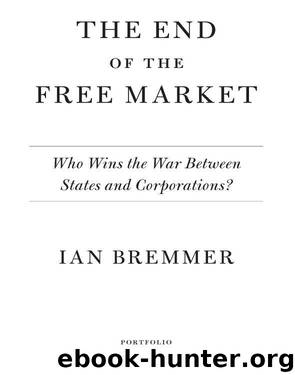The End of the Free Market by Ian Bremmer

Author:Ian Bremmer
Language: eng
Format: epub
Publisher: Penguin USA, Inc.
Published: 2010-04-26T04:00:00+00:00
Almost all the countries profiled so far have some form of authoritarian government. But some democratic governments also use state-capitalist tools to achieve political goals.
India
It has become conventional wisdom that from independence in 1947 until at least the late 1980s, India’s economic policy reflected the statist personal views of prime ministers Jawaharlal Nehru and his daughter, Indira Gandhi. During that time, successive governments enforced state dominance of many economic sectors, rigid market regulation, and laws that protected local companies from foreign competition. But in 1991, an Indian government facing financial crisis embraced free-market reform as a matter of political survival. It began breaking up state monopolies and unshackling India’s private sector, welcoming unprecedented levels of trade and foreign investment. In recent years, market reformers have begun freeing the country’s entrepreneurs to drive India toward a future as an economic powerhouse.
There’s a lot of truth in this historical simplification, but India remains poised between the state-dominated economic model of an earlier era and one driven by private enterprise. There are three main reasons why India’s government continues to resist a full embrace of free-market capitalism. First, few Indian politicians will say publicly that free markets produce faster growth. Second, India’s poorest citizens vote in unusually large numbers, and state officials fear the price these voters will exact if government imposes long-term reforms that inflict near-term pain. Third, true state dominance is a tough habit to break—particularly when it’s the state that must break it. Indian governments have liberalized the country’s industrial and trade policies over the past twenty years to make life easier for large Indian companies, but officials explain these plans in different ways to different audiences. There is now more confidence within the leadership that markets sometimes deliver where the state cannot, and that has triggered a genuine debate within society over how best to fight poverty and spur development. With the 2009 elections, India’s Communist Party, a major obstacle to reform in recent years, won its smallest vote percentage since 1952. But that debate is not yet won, and it will always be politically safer to avoid serious discussion of cuts in state subsidies or the reform of dysfunctional social-welfare programs. The strength of the Congress Party-led government’s commitment to any particular plan is tested each week with the release of new economic statistics and political opinion polls.
India’s government still organizes economic policy according to five-year plans that are created, implemented, and monitored by a state planning commission chaired by the prime minister. State involvement in some sectors remains high, particularly when it comes to politically sensitive products like food, fuel, fertilizer, electricity, and water. Subsidies are useful, because they allow the government to manipulate prices for political reasons. But they also cost state-owned enterprises in these sectors large amounts of money, and state budgets take a considerable hit. That’s why the Indian government has forced state-owned companies to compete with privately owned rivals in sectors like oil and gas, airlines, power, metals, and defense. Privatizing state-owned firms
Download
This site does not store any files on its server. We only index and link to content provided by other sites. Please contact the content providers to delete copyright contents if any and email us, we'll remove relevant links or contents immediately.
International Integration of the Brazilian Economy by Elias C. Grivoyannis(74739)
The Radium Girls by Kate Moore(11621)
Turbulence by E. J. Noyes(7700)
Nudge - Improving Decisions about Health, Wealth, and Happiness by Thaler Sunstein(7242)
The Black Swan by Nassim Nicholas Taleb(6763)
Rich Dad Poor Dad by Robert T. Kiyosaki(6174)
Pioneering Portfolio Management by David F. Swensen(6078)
Man-made Catastrophes and Risk Information Concealment by Dmitry Chernov & Didier Sornette(5646)
Zero to One by Peter Thiel(5488)
Secrecy World by Jake Bernstein(4388)
Millionaire: The Philanderer, Gambler, and Duelist Who Invented Modern Finance by Janet Gleeson(4094)
The Age of Surveillance Capitalism by Shoshana Zuboff(3983)
Skin in the Game by Nassim Nicholas Taleb(3965)
The Money Culture by Michael Lewis(3846)
Bullshit Jobs by David Graeber(3829)
Skin in the Game: Hidden Asymmetries in Daily Life by Nassim Nicholas Taleb(3722)
The Dhandho Investor by Mohnish Pabrai(3560)
The Wisdom of Finance by Mihir Desai(3523)
Blockchain Basics by Daniel Drescher(3329)
